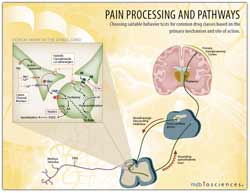4 min read


Adequate pain relief following surgical procedures is well-documented to improve the degree and time course of patient recovery. Nontheless, post-operative pain remains grossly under treated, with up to 70% of patients reporting moderate to severe pain following surgery (1). Perhaps the biggest underlying contributor to the under treatment of post-operative pain is simply a lack of information, both on the part of basic scientists as well as clinicians. Scientists are in the relatively early stages of investigation into the specific mechanisms contributing to the development of incisional pain, which may differ from those mediating acute pain induced by chemical or inflammatory algesic agents. Currently, clinicians essentially rely on treatments that have been developed for other painful conditions, most notably opioids, the side effects of which can hinder rehabilitation and recovery.
Because opioids are the mainstay treatment for post-operative pain, as well as many other painful conditions, a lack of education regarding the incidence of side effects and abuse potential of this class of drugs can also contribute to under treatment. Proper use of adjuvants to opioid therapy and other currently available treatments is imperative for improving post-operative pain in the short-term.
A better understanding of the mechanisms of post-operative pain will undoubtedly improve pain management following surgery and allow clinicians to better tailor treatment to individual patients and procedures. The development of novel alternatives to conventional opioid-based analgesia as well as new devices and delivery methods will be essential for improving post-operative pain relief.
Current Treatments for Post-operative Pain
Opioid drugs such as morphine are widely used in the treatment of post-operative pain, particularly following major surgery. Although they are typically efficacious with regard to pain relief itself, the adverse side effects that accompany opioid administration often limit the utility of this class of drugs. As such, other treatments are often used in conjunction with opioid administration in order to achieve analgesia while reducing opioid treatments. For example chlonidine, an a2-adrenergic receptor agonist, sometimes accompanies fentanyl or other opioids given via epidural administration. In addition, opioids are typically more effective for treating pain occuring at rest rather than evoked pain caused by movement or coughing; therefore, combination therapy can also be useful for improving and hastening recovery and rehabilitation (3). This is an important aspect of post-operative pain treatment to consider, as severe pain and lack of mobility following surgery are risk factors for the development of chronic pain syndromes (4).
Non-steroidal anti-inflamatory drugs (NSAIDs) are a second class of drugs that are typically given to patients following surgery. In fact, nearly all patients receive some kind of NSAID to treat post-operative pain (4). They may not provide sufficient pain relief on their own, especially after major surgery, but can be combined with opioids or other interventions to improve analgesia.
Afferent neutral blockage, although not employed with particularly high frequency in the clinic, is an analgesic treatment that has gained more attention from preclinical researcher in recent years. One important benefit of local anasethetics, such as lidocaine, is that they are effective for treating mobilization-evoked pain and may improve long-term patient outcomes (4). In addition, this class of drugs is relatively safe and well tolerated. However, these drugs also have non-selective effects on neuronal transmission, so normal sensory perception is affected. In addition, there are some associated cardiac and neurological risks, especially with systemic delivery.
References: